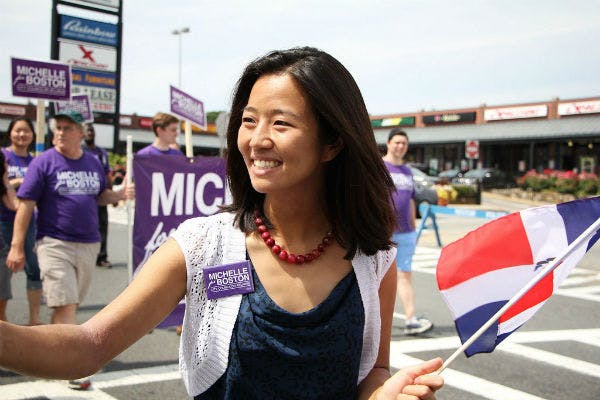Pedaling prosperity: For Boston's council president,'safe streets' aren't enough
By: Michael Andersen, local innovation staff writer

Few of the great cities of the United States have more potential for biking growth than Boston.
It’s too dense for driving to be pleasant or parking to be cheap, but it’s not so dense that mass transit can be everywhere. It’s full of universities, which for many reasons tend to be compatible with biking among both employees and students.
The difference between Boston and bike-friendlier cities like Philadelphia or San Francisco is mostly just that with a few exceptions, its politicians haven’t been enthusiastic about the potential of bike transportation.
But an op-ed in the Boston Globe last week by Boston City Council President Michelle Wu has given us more hope than we’ve had in years that this might be changing.
Wu wrote it after returning from a “Climate Innovations” study tour to Copenhagen. But the insights she took home seem to have gone far beyond fuel savings. Boldface ours:
Safety is just the baseline benefit of world-class cycling infrastructure. When every street has bike lanes shielded from cars by a curb or median, cyclists ride without fear, and more people become cyclists: women, seniors, even kids riding alongside their parents. Safe infrastructure means cycling becomes an affordable transportation option open to all.
In Copenhagen, cyclists make up 45 percent of all commuters, and city planners have quantified the benefits. Adding up costs avoided by reducing traffic congestion, noise, crashes, wear and tear on infrastructure, and air pollution, they estimate 64 cents of net social gain from every mile traveled by bike instead of car. More residents getting regular exercise drives down health care costs by an estimated 61 cents per mile cycled. …
Boston’s streets, on the other hand, are designed for conflict. Painted bike lanes function as space for double-parked delivery trucks, pushing cyclists into traffic. Posted signs and "sharrows" unrealistically ask drivers and cyclists to get along. The result is that only 1.9 percent of Boston commuters are willing to risk a bicycle trip — the bravest and most aggressive cyclists, who often provoke anxiety and rage in drivers. …
For Boston, the urgency goes well beyond safety. Our continued economic growth depends on solving our transportation crunch. With a struggling public transit system that won?t be expanding service anytime soon, already gridlocked roadways will have to absorb many of the more than hundred thousand additional commuters projected by 2030. Carving out space for protected bike lanes is the most cost-effective way to increase our transit capacity and move more people on our streets.
To be clear, building a seamless and convenient network of protected cycling infrastructure will require trade-offs. On many streets, adding a cycle track means narrowing or removing car lanes, or eliminating on-street parking — scenarios that bring panic to car and business owners. Although research suggests that retail sales actually increase after switching parking for protected bike lanes, the proposals rarely see support from abutters. Yet we must acknowledge that our current transportation situation isn’t working for all residents, and it will worsen unless we take bold action to empower more affordable and sustainable options.
How much do we love this op-ed? Let us count the ways.
1) Universal appeal. Wu presents protected bike lanes, accurately, not as a way to appease or protect a minority but as a way to enhance the lives of the majority by giving ordinary people a pleasant option to ride when and where they want. By pointing out that only the “bravest and most aggressive cyclists” would choose to ride on Boston streets today, she positions herself — and the comfortable biking network she supports — in opposition to the stereotypical jerk on a bike. Even if you want to say “sure, but it’s the jerks in cars who are actually dangerous,” you have to admire her rhetorical skill.
2) Geometric realism. Boston is a pillar of the U.S. economy. This can only continue as long as people can move within it. Wu understands that in the end, getting more trips out of cars and onto space-efficient bikes isn’t a matter of ideology or environmentalism or even affordable mobility. It’s a matter of mathematics.
3) Honesty about tradeoffs. Many leaders are politicians, but not all politicians are leaders. Here’s how you can tell the difference: A politician who is also a leader is honest with her constituents about the fact that there’s an upside and a downside to every decision. The key to helping constituents face this sometimes difficult truth is to communicate that sticking with the status quo will have downsides, too. That’s exactly the point Wu makes here.
The day after her op-ed ran, Wu asked her Facebook followers for suggestions of local streets where a bike lane and parking lane could be swapped.
Wu clearly thinks the tradeoffs of protected bike lanes are worth it. The world’s best biking cities are her proof.
Without leaders, no cities could ever have become great. If Wu and her colleagues in Boston keep leading this way on transportation issues, we’ll be eager to see the new greatness Boston will achieve in the decades to come.

